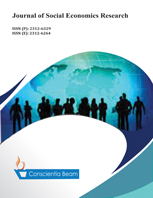Socioeconomic Determinants of Drug Abuse in the United States
DOI:
https://doi.org/10.18488/journal.35.2021.81.39.49Abstract
We examine the association between drug abuse and several socioeconomic variables by estimating a multivariate regression model. The sample data includes seventy observations at the county-level from every state in the U.S., excluding Maryland and North Dakota, provided by the U.S. Center for Disease Control and the U.S. Census Bureau. The socioeconomic variables analyzed in the model are education, median household income, community poverty, insurance status, and employment status. The income, education, and community poverty variables are shown to have significant effect on the number of unintentional drug poisonings (drug abuse). Income is shown to have the largest effect followed by community poverty and then education. Neither insurance status nor employment status were found to be statistically significant. Empirical results suggest that encouraging higher levels of education for communities may be beneficial in reducing drug abuse and its consequences. In the short-run drug related information may can be made accessible through community centers, community clinics, and religious temples.

